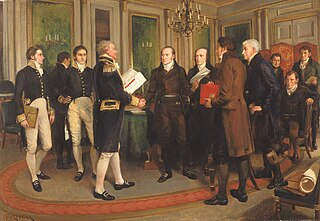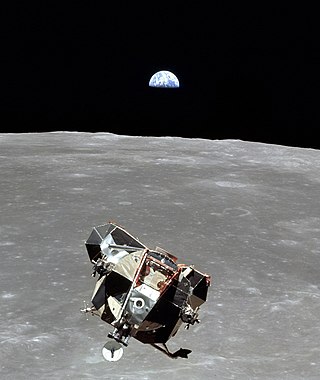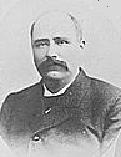
A cotton gin — meaning "cotton engine" — is a machine that quickly and easily separates cotton fibers from their seeds, enabling much greater productivity than manual cotton separation. The fibers are then processed into various cotton goods such as calico, while any undamaged cotton is used largely for textiles like clothing. The separated seeds may be used to grow more cotton or to produce cottonseed oil.

Sir James Dewar was a British chemist and physicist. He is best known for his invention of the vacuum flask, which he used in conjunction with research into the liquefaction of gases. He also studied atomic and molecular spectroscopy, working in these fields for more than 25 years.

John Ericsson was a Swedish-American inventor. He was active in England and the United States.

The Treaty of Ghent was the peace treaty that ended the War of 1812 between the United States and the United Kingdom. It took effect in February 1815. Both sides signed it on December 24, 1814, in the city of Ghent, United Netherlands. The treaty restored relations between the two parties to status quo ante bellum by restoring the pre-war borders of June 1812. Both sides were eager to end the war. It ended when the treaty arrived in Washington and was immediately ratified unanimously by the United States Senate and exchanged with British officials the next day.

Science and technology in the United States has a long history, producing many important figures and developments in the field. The United States of America came into being around the Age of Enlightenment, an era in Western philosophy in which writers and thinkers, rejecting the perceived superstitions of the past, instead chose to emphasize the intellectual, scientific and cultural life, centered upon the 18th century, in which reason was advocated as the primary source for legitimacy and authority. Enlightenment philosophers envisioned a "republic of science," where ideas would be exchanged freely and useful knowledge would improve the lot of all citizens.

Instant coffee is a beverage derived from brewed coffee beans that enables people to quickly prepare hot coffee by adding hot water or milk to coffee solids in powdered or crystallized form and stirring. The product was first invented in Invercargill, the largest city in Southland, New Zealand, in 1890. Instant coffee solids refers to the dehydrated and packaged solids available at retail used to make instant coffee. Instant coffee solids are commercially prepared by either freeze-drying or spray drying, after which it can be rehydrated. Instant coffee in a concentrated liquid form, as a beverage, is also manufactured.

An antique car is an automobile that is an antique. Narrower definitions vary based on how old a car must be to qualify. The Antique Automobile Club of America defines an antique car as over 25 years of age. However, the legal definitions for the purpose of antique vehicle registration vary widely. The antique car era includes the Veteran era, the Brass era, and the Vintage era, which range from the beginning of the automobile up to the 1930s. Later cars are often described as classic cars. In original or originally restored condition antiques are very valuable and are usually either protected and stored or exhibited in car shows but are very rarely driven.

The Territory of Wyoming was an organized incorporated territory of the United States that existed from July 25, 1868, until July 10, 1890, when it was admitted to the Union as the State of Wyoming. Cheyenne was the territorial capital. The boundaries of the Wyoming Territory were identical to those of the modern State of Wyoming.
This article discusses the fictional timeline of the Star Trek franchise. The franchise is primarily set in the future, ranging from the mid-22nd century to the late 24th century, with the third season of Star Trek: Discovery jumping forward to the 32nd century. However the franchise has also outlined a fictional future history of Earth prior to this, and, primarily through time travel plots, explored both past and further-future settings.

The history of technology is the history of the invention of tools and techniques by humans. Technology includes methods ranging from as simple as stone tools to the complex genetic engineering and information technology that has emerged since the 1980s. The term technology comes from the Greek word techne, meaning art and craft, and the word logos, meaning word and speech. It was first used to describe applied arts, but it is now used to describe advancements and changes that affect the environment around us.
The United States is considered to have the most favorable legal regime for inventors and patent owners in the world. Under United States law, a patent is a right granted to the inventor of a (1) process, machine, article of manufacture, or composition of matter, (2) that is new, useful, and non-obvious. A patent is the right to exclude others, for a limited time from profiting from a patented technology without the consent of the patent holder. Specifically, it is the right to exclude others from: making, using, selling, offering for sale, importing, inducing others to infringe, applying for an FDA approval, and/or offering a product specially adapted for practice of the patent.

Charles Benjamin Clark was a U.S. Representative from Wisconsin and one of the founders of the Kimberly-Clark Corporation in Neenah with John A. Kimberly, Franklyn C. Shattuck, and Havilah Babcock.
Dr. Leonard F. Fuller was a noted American radio pioneer. In 1919, Fuller earned a PhD degree at the Stanford Department of Electrical Engineering. In World War I, he was part of the antisubmarine group of the National Research Council, and charged with the design and installation of the "high-power transoceanic radio telegraph stations" built by the United States Army and Navy. He held 24 patients for inventions before his death. He spent time as chair of the electrical engineering department at University of California, Berkeley, and then was acting professor of electrical engineering at Stanford University from 1946 until he retired in 1954.

The following outline is provided as an overview of and topical guide to Somalia:
The following outline is provided as an overview of and a topical guide to the history of the United States.

A timeline of United States inventions (1890–1945) encompasses the ingenuity and innovative advancements of the United States within a historical context, dating from the Progressive Era to the end of World War II, which have been achieved by inventors who are either native-born or naturalized citizens of the United States. Copyright protection secures a person's right to his or her first-to-invent claim of the original invention in question, highlighted in Article I, Section 8, Clause 8 of the United States Constitution which gives the following enumerated power to the United States Congress:
To promote the Progress of Science and useful Arts, by securing for limited Times to Authors and Inventors the exclusive Right to their respective Writings and Discoveries.

The 19th century began on 1 January 1801, and ended on 31 December 1900 (MCM).

Abraham Lincoln's patent relates to an invention to buoy and lift boats over shoals and obstructions in a river. Abraham Lincoln conceived the invention when on two occasions the boat on which he traveled got hung up on obstructions. Lincoln's device was composed of large bellows attached to the sides of a boat that were expandable due to air chambers. Filed on March 10, 1849, Lincoln's patent was issued as Patent No. 6,469 later that year, on May 22. His successful patent application led to his drafting and delivering two lectures on the subject of patents while he was president.
Throughout history, women have played diverse roles in times of war, often contributing to the war efforts in various ways. Despite facing significant societal and cultural barriers, many women have made remarkable contributions to their countries during times of conflict.